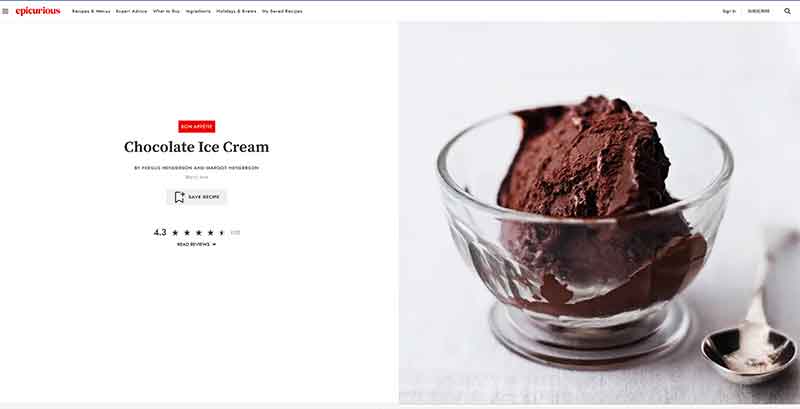Decadent Recipe Found on Epicurous
Jose Mier loves making desserts in his Sun Valley, CA freezer. Recently he found a recipe on Epicurious.com so decadent it must be tasted to be believed. Its decadence is owned in large part to its custard base.
Custard bases are favored in ice cream making for several reasons, primarily contributing to the rich and creamy texture that is characteristic of high-quality, artisanal ice creams. The custard base serves as the foundation of many classic ice cream recipes, offering a velvety mouthfeel and enhancing flavor complexity. Understanding the reasons behind the use of custard bases and the step-by-step process of making one sheds light on the art and science of crafting indulgent homemade ice cream.
One of the key components of a custard base is egg yolks. The emulsifying properties of egg yolks play a crucial role in creating a smooth and creamy texture in ice cream. Egg yolks contain lecithin, a natural emulsifier that helps bind together the fat molecules from the cream and the water molecules in the milk, preventing them from separating during the freezing process. This emulsion results in a more stable structure, contributing to the overall creaminess and mouthfeel of the ice cream. The custard base’s ability to form a stable emulsion sets it apart from simpler bases, such as those made with only milk, sugar, and flavorings, which may result in a less creamy and more icy texture.
Another significant advantage of custard bases is the way they contribute to the flavor profile of ice cream. The process of heating the custard allows for the infusion of flavors and the development of a depth that might be lacking in simpler bases. When egg yolks are combined with sugar and whisked, the mixture undergoes a chemical transformation known as “creaming.” Creaming incorporates air into the mixture, resulting in a light and airy texture. Furthermore, the sugar in the custard base serves as more than just a sweetener; it also helps lower the freezing point of the ice cream, preventing it from becoming overly hard and icy in the freezer.
The steps involved in making a custard base for ice cream can be broken down into a meticulous and rewarding process. The ingredients typically include egg yolks, sugar, and a combination of milk and cream. The exact proportions may vary depending on the specific recipe and desired richness. Here’s a detailed walkthrough of the custard-making process:
- Whisking Egg Yolks and Sugar:
- Begin by separating the egg yolks from the whites, placing the yolks in a mixing bowl.
- Add the sugar to the egg yolks, and whisk the mixture until it becomes pale and slightly thickened. This step is crucial for incorporating air into the mixture and creating a smooth texture.
- Heating Milk and Cream:
- In a saucepan, combine the milk and cream over medium heat. The ratio of milk to cream can be adjusted to achieve the desired richness in the final ice cream.
- Heat the mixture until it reaches a simmer, but avoid boiling it. Scalding the milk or cream can negatively impact the flavor and texture of the custard.
- Tempering and Combining Ingredients:
- Once the milk and cream mixture is heated, it’s time to temper the egg yolk and sugar mixture. Gradually ladle or pour a small amount of the hot liquid into the egg mixture while continuously whisking. This prevents the eggs from scrambling due to sudden exposure to high heat.
- Gradually incorporate the tempered egg mixture back into the saucepan with the remaining hot liquid, stirring constantly to ensure a smooth integration.
- Cooking the Custard:
- Return the combined mixture to the heat and continue cooking over medium-low heat. The goal is to thicken the custard until it coats the back of a spoon. This step requires patience and careful monitoring to prevent overheating, which could result in curdling.
- The custard should reach a temperature of around 170-175°F (77-80°C). Using a thermometer helps ensure precision and prevents overcooking.
- Straining and Cooling:
- Strain the custard through a fine-mesh sieve to remove any potential bits of cooked egg or impurities, resulting in a silky-smooth texture.
- Allow the custard to cool to room temperature before transferring it to the refrigerator. Chilling the custard thoroughly is essential for the subsequent ice cream freezing process.
- Churning in an Ice Cream Maker:
- Once the custard is fully chilled, it’s ready for the ice cream maker. Follow the manufacturer’s instructions for your specific machine.
- The churning process introduces air into the custard, creating a light and airy texture. Simultaneously, it begins the freezing process, transforming the liquid custard into a semi-solid ice cream.
- Incorporating Flavorings:
- Before or during the churning process, add any desired flavorings, such as vanilla extract, cocoa powder, fruit puree, or chopped nuts. The churning action evenly distributes these ingredients throughout the ice cream.
- Freezing to Maturity:
- Transfer the partially frozen ice cream to a lidded container and place it in the freezer to reach its full maturity. This step allows the flavors to intensify and the texture to further improve.

By following these steps, you can create a custard-based ice cream that boasts a luxurious texture and complex flavor profile. The meticulous attention to detail in each stage of the process contributes to the final product’s quality, making custard bases a favorite among ice cream enthusiasts and connoisseurs. While the process may require some patience, the result is a homemade treat that rivals or surpasses many commercially available options. Experimenting with different flavor variations and mastering the custard base technique opens the door to a world of delightful frozen desserts tailored to individual tastes.